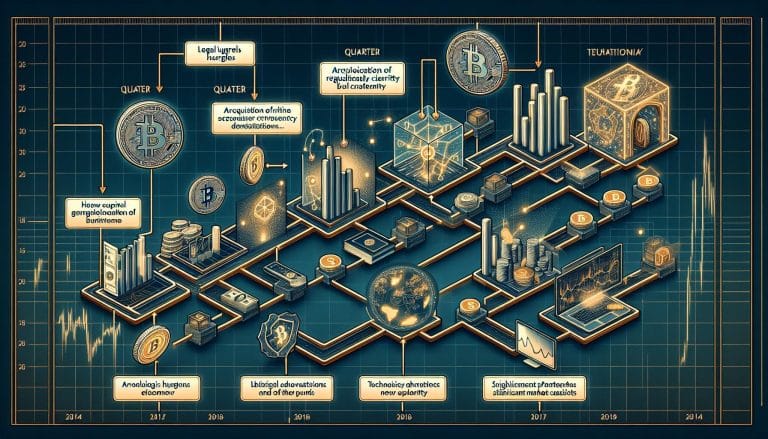Xrp Ecosystem Use Cases
XRP is the native currency of the Ripple network, an open-source protocol which enables users to send money across borders in a fast and cost-effective manner. The XRP ecosystem consists of various services that enable businesses and individuals to make payments with XRP, settle financial transactions, enhance liquidity in financial markets, and support digital asset exchanges. This article explores the various use cases for businesses and individuals that take advantage of the features offered by Ripple’s XRP ecosystem. It looks at how businesses can benefit from using it as well as potential applications that could be developed using this technology. Furthermore, it examines how individuals can benefit from its features in order to efficiently transfer funds quickly and securely.
Overview of the XRP Ecosystem
The XRP Ecosystem is a collection of digital technologies that facilitate the transfer and exchange of funds in a secure and efficient manner. The decentralized network allows users to make transactions quickly, securely, and without having to rely on any third parties or intermediaries. Additionally, it enables cross-border payments at much lower costs than traditional methods. This facilitates cryptocurrency adoption by providing an easy and affordable way for individuals and businesses to send money globally. With the increasing popularity of cryptocurrency transactions, the XRP ecosystem has become an important part of global payments infrastructure. It provides a reliable platform for sending money around the world while eliminating delays associated with traditional payment systems. As such, it has enabled many new use cases for global payments that were previously not possible.
Global Payments
The ability to make cross-border payments quickly and securely is an essential component of global commerce. Ripple’s XRP Ledger technology offers a unique solution that makes international payments faster, more efficient, and more compliant with regulations than ever before. With its decentralized distributed ledger, XRP provides a secure platform for facilitating transactions between different currencies within seconds while also allowing users to easily comply with relevant laws and regulations.
Cross-border payments
Rippling across borders, XRP enables fast and cost-efficient cross-border payments, allowing businesses to reach new markets in a flash. Since the transactions are settled in seconds, it removes the need for costly intermediaries that would otherwise take days to settle payments. Additionally, by making use of its blockchain technology, XRP can help with liquidity optimization by providing immediate access to funds and capitalizing on real time payments. With this increased speed and efficiency of payment processing comes an added benefit of compliance with regulations due to the visibility and traceability it offers. This allows companies to adhere to different regulations in various countries while still being able to complete cross border transfers quickly and securely.
Compliance with regulations
By leveraging blockchain technology, XRP provides visibility and traceability to ensure compliance with regulations in different countries for more efficient cross border payments. This means that organizations can achieve data privacy while also preserving interoperability between disparate systems. As a result, XRP is well positioned to facilitate compliance with regulations around the world.
| Country | Regulation |
|---|---|
| USA | KYC |
| UK | AML |
| France | PSD2 |
| Canada | Data Privacy |
This visibility and traceability of transactions helps organizations to comply with regulations such as Know Your Customer (KYC) in the US, Anti Money Laundering (AML) in the UK, Payment Services Directive 2 (PSD2) in France and data privacy laws in Canada. As a result, XRP provides an effective way of settling financial transactions while still meeting global regulatory requirements.
Settlement of Financial Transactions
Utilizing XRP as a fast, secure, and cost-effective means of settling financial transactions can allow for increased efficiency in the global payments market. Due to its instant settlement times, businesses are able to access funds more quickly than with traditional payment systems. This reduces costs associated with maintaining liquidity and providing capital to cover payment processing fees. Additionally, XRP enables financial institutions to reduce their reliance on often expensive and inefficient correspondent banking relationships.
XRP also provides significant cost savings compared to other digital assets by eliminating the need for costly currency conversions between different fiat currencies or digital tokens when transferring money across borders. As a result, this allows businesses and individuals to save on international transaction fees while still being able to instantly settle transactions regardless of which fiat currency is involved. By enabling faster settlements at reduced costs, XRP has the potential to enhance liquidity in financial markets around the world.
Enhancing liquidity in financial markets
By leveraging its instantaneous settlement times, XRP has the potential to facilitate global liquidity in financial markets. Real-time settlement of trades made with XRP eliminates the need for a bank or other type of third party to mediate transactions, thus allowing faster and more efficient settlements. As a result, this can lead to improved liquidity optimization due to the immediate availability of funds. XRP is also known for its low transaction costs as compared to traditional money transfers and wire services, further enhancing liquidity in financial markets by reducing overall overhead costs associated with trading. Additionally, because it is not tied to any one country or currency, XRP allows users from around the world to take part in international trading without having their funds go through lengthy conversion processes. This makes it easier for traders from different parts of the world to access global markets and optimize their investments. By facilitating real-time settlements and improved liquidity optimization through reduced fees and frictionless international trading, XRP stands poised to dramatically enhance global liquidity in financial markets. With these advantages, XRP supports digital asset exchanges that require quick transactions and low overhead costs.
Supporting digital asset exchanges
Decentralized exchanges, or DEXs, are becoming increasingly popular as a way to securely exchange digital assets. These transactions are protected by an additional layer of security that prevents malicious actors from interfering with the trading process. This provides peace of mind for users who can be sure their digital asset investments are secure and safe from hackers. Moreover, DEXs allow users to access liquidity pools in ways that weren’t previously possible before the development of these decentralized systems.
Decentralized exchanges
The deployment of decentralized exchanges on the XRP Ledger allows for peer-to-peer transactions to take place in a secure and trustless environment. This provides numerous use cases that can be applied to different sectors, such as project financing or supply chain management. For example, it enables users to securely transfer digital assets without the need for a centralized authority, allowing them to initiate transactions quickly with minimal risk. Additionally, it eliminates counterparty risk by providing an immutable record of all asset transfers and interactions on the ledger.
| Benefits | Drawbacks |
|---|---|
| Quick transaction times | Lack of regulation |
| Low cost for transferring assets | Difficulty in navigating platform |
| Increased security and trustlessness | Limited features & liquidity |
Furthermore, decentralized exchanges offer enhanced security when compared to their centralized counterparts as they are not vulnerable to single point of failure attacks due to their distributed nature. However, they also come with some drawbacks such as lack of regulation which could result in potential money laundering activities or scams taking place. Moreover, users may find it difficult to navigate these platforms due to their limited features and liquidity coupled with complex user interfaces. Nevertheless, despite these drawbacks the advantages offered by decentralized exchanges make them an attractive option for those seeking a secure and trustless environment for transacting digital assets on the XRP Ledger. Thus, transitioning into the subsequent section about ‘security of transactions’.
Security of transactions
Transactions on the XRP Ledger are characterized by trustlessness and increased security, providing users with a secure platform for value transfer. Data privacy is ensured through the use of decentralized transactions with cryptographic signatures that validate the sender and receiver of funds. This approach greatly reduces the risk of fraud by verifying each transaction in real-time against an immutable ledger that is accessible to all participants, further ensuring its accuracy. Additionally, fraud prevention is strengthened with the ability to draw on an extensive network of validators to approve each transaction before it can be added to the ledger. In this way, users can be certain that their information remains secure and their transactions will remain unaltered while being transferred across networks. As such, these features make XRP ideal for businesses looking for a reliable means of transferring funds quickly and securely without compromising data privacy or incurring additional costs associated with third-party intermediaries. The conclusion thus offers a clear transition into discussing use cases for businesses.
Use Cases for Businesses
By leveraging XRP’s features, businesses can realize a variety of different use cases that allow for cost-effective and efficient transactions. These use cases include mobile payments, which are enabled through digital wallets and the XRP ledger. With mobile payments, businesses can transfer money instantly with low fees regardless of geographic location or currency type. Furthermore, the technology behind XRP provides improved security over traditional payment methods as it does not require bank accounts or credit cards to process transactions. This makes it difficult for hackers to access sensitive financial information and thus helps protect businesses from fraud and other malicious activities.
The technology underlying XRP also offers additional benefits such as faster transaction times than traditional payment systems, allowing businesses to quickly complete transactions without waiting days for confirmation or authorization. Additionally, its distributed ledger system allows multiple parties to keep track of their own records while verifying each others’, making record management more transparent and accurate across multiple entities involved in a transaction. As such, XRP is an ideal solution for facilitating secure business transactions on a global scale. Moving forward into the next section, we will explore the various use cases available to individuals within the XRP ecosystem.
Use Cases for Individuals
Moving away from the use cases of businesses, individuals too have started to leverage XRP for their everyday needs. XRP provides multiple benefits such as low transaction fees and fast settlements that make it an attractive option for individuals looking to utilize digital currency. In particular, there are several use cases that can be enabled by XRP:
- Retail payments: XRP can be used to make purchases from retailers both online and in-store using a mobile wallet on a smartphone or other device. This allows users to pay with ease without needing cash or credit cards.
- Online banking: Individuals can also use XRP to transfer funds quickly and securely between bank accounts around the world without having to wait days or incur expensive fees associated with international transfers.
- Remittances: Those who need to send money abroad can do so conveniently and cost-effectively with XRP since transactions settle almost instantly and at very low costs compared with traditional methods like wire transfers.
- Investment opportunities: Investors may find various investment opportunities related to the growth of the XRP ecosystem as well as its underlying technology, making it an attractive asset class for those seeking diversification in their portfolios.
Overall, these use cases demonstrate how individual customers can take advantage of the benefits offered by XRP in their daily lives, providing them access to convenient payment solutions while also allowing them potential returns on investment through innovative applications.
Potential for Innovative Applications
The potential of XRP to facilitate fast and cost-effective transactions has opened up an exciting range of possibilities for innovative applications. By leveraging the power of blockchain technology, the XRP ecosystem is able to support new use cases that would otherwise be impossible or prohibitively expensive. Smart Contracts are one example, allowing users to automatically execute a contract without the need for trust or a third party. Digital Identity systems enable users to securely access data and services without having to reveal their identity, while remittance services allow people around the world to send money quickly and cheaply with minimal fees. These use cases have great potential in areas such as finance, commerce, healthcare, insurance, education and more. As development continues on the XRP network, it is likely that even more innovative applications will become available in the near future.
Frequently Asked Questions
What other digital assets does the XRP Ecosystem support?
The XRP ecosystem enables trustless transactions and liquidity pooling across various digital assets, such as Bitcoin, Ethereum, Litecoin and many others. With its secure infrastructure and vast network of participants, it ensures seamless transfers of value without compromising the safety or privacy of users.
How secure is the XRP Ecosystem?
The security of Ripple mining and decentralized exchanges is ensured through a combination of network-wide consensus protocols, cryptographic algorithms, and distributed ledger technology. These measures ensure the safety of users’ funds and data with minimal risk.
How does the XRP Ecosystem help businesses save money?
By leveraging cost and time savings, businesses utilizing the XRP ecosystem can reap significant rewards. Through its unique capabilities, it offers a revolutionary way to reduce operational costs and increase efficiency. With the ability to quickly transact with low fees, businesses can benefit greatly from this cutting-edge technology.
What advantages does XRP have over other digital assets?
XRP offers advantages over other digital assets such as speed optimization and liquidity pooling. Transactions are settled quicker, with faster processing times compared to other digital assets. XRP also allows for liquidity pooling, making it easier for businesses to access global markets without the need for multiple exchanges or intermediaries.
What are the risks associated with using the XRP Ecosystem?
The use of XRP entails risks such as regulatory uncertainty and higher transaction fees than other digital assets. It also carries the risk of price volatility, technological complexity and relative lack of liquidity.




